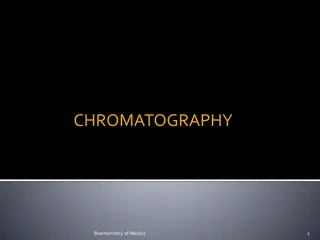Understanding Chromatography for Chemical Analysis
Explore the applications of chemical analysis, learn about chromatography as a technique for separating components based on size and polarity, conduct paper chromatography experiments, and analyze the results to understand the principles behind this method.
Download Presentation

Please find below an Image/Link to download the presentation.
The content on the website is provided AS IS for your information and personal use only. It may not be sold, licensed, or shared on other websites without obtaining consent from the author. Download presentation by click this link. If you encounter any issues during the download, it is possible that the publisher has removed the file from their server.
E N D
Presentation Transcript
Starter 1. What are the applications for chemical analysis? 2. What is chromatography? 3. What does the separation of components depend on?
Learning Intention Learn how differences in size and polarity of molecules can be used to separate mixtures by chromatography. Success Criteria I can use paper chromatography to separate dyes in two sweets using a variety of solvents (practical) I can breakdown (analysis) why solvents separate the dyes differently I can decide (evaluate) which solvent is best to separate the dyes
Paper http://chemsite.lsrhs.net/FlashMedia/html/p aperChrom.html
Chromatography experiment 1. 2. 3. 4. Draw a line with a pencil 2 cm from the bottom of the paper. Use a paint brush and water to wet your sweet. Add a small dot of the ink from the paint brush onto the line. Allow the dot to dry then add another drop of ink. Repeat a number of times until the spot is concentrated. Repeat steps 1 to 4 four times so you have four pieces of paper for both colours In separate boiling tubes, add 2cm3 of water, ethanol and propanone (I have done the toluene for you in the fume hood). Carefully place the paper into the boiling tubes making sure that the ink line does not touch the liquid. Leave the chromatography to run until the solvent is no more than 3 cm from the end of the paper. Once this happens remove the paper and draw a line showing where the solvent reached 5. 6. 7. 8.
Things to think about Is the solvent polar? Which dye moves the furthest? What does that indicate about the polarity of the dye? What does that indicate about the polarity of the stationary phase? Why might the dye on the line not have moved?
Column http://chemsite.lsrhs.net/FlashMedia/html/c olumnChrom.html
Gas https://www.youtube.com/watch?v=OnQgl XDvzTc























